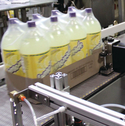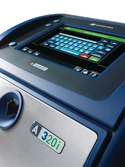Marking time on the job
4 August 2011With a bumper crop of new coding and marking systems on the market, packer fillers now have more choice in directly applying the optimum technology to both primary and secondary packaging, reports Sam Cole.
The difficulty now is determining which direct to substrate coding technology to opt for, as the development of increasingly sophisticated digital inkjet solutions has undermined what was once a reasonably clear set of demarcation lines based upon a rudimentary ‘horses for courses’ principle. viz. thermal transfer for barcodes; laser engraving for metal or glass, etc.
In many ways it’s a nice problem for packer fillers to have to contend with; less so, arguably, for systems developers, many of whom, regardless of original core competence, now seek to offer as many different options as possible.
Several of these were unveiled at this year’s interpack exhibition (Düsseldorf: 12 – 18 May), with leading suppliers such as Domino and Linx rolling out new developments incorporating notably both thermal transfer (TT) and continuous inkjet (CIJ) technologies.
Thermal transfer
Designed for printing high resolution codes, text and images onto flexible foils, films and labels, Domino’s addition to its V-Series thermal transfer overprinting (TTO) systems – the V220i – incorporates a range of smart features to deliver consistent coding performance and quality. Running costs are kept as low as possible and there is a choice of 300dpi printheads (32mm or 55mm), catering for the diverse requirements of the food and healthcare sectors for information to be applied over a variety of print widths.
The printer handles complex coding information including text, linear and 2D barcodes, and logos and interfaces with code management databases to facilitate the application of unique information at item level. Domino’s proprietary ribbon drive is said to reduce usage by up to 60% c/f competing systems, without sacrificing print quality. This feature also maximises uptime by significantly increasing effective ribbon length up to 1,625m, it is claimed.
The Linx TT5 and TT10 over-printers are designed to optimise productivity with their unique clutchless bi-directional ribbon drive to minimise risk of ribbon breaks and eliminating the need for mechanical adjustments to maintain ribbon tension. The TT5 has a standard ribbon width up to 55mm, and is especially suitable for printing best before dates and batch codes onto packaging film and labels. It also has one of the longest standard ribbon lengths on the market (1,000m) resulting in fewer ribbon changes.
The TT10 system has a 110mm width ribbon making it suitable for printing longer messages including ingredients, logos and marketing messages across a wide range of flexible packaging applications.
TT technology is widely regarded as the optimum solution for printing codes on multi-lane vertical form-fill-seal packaging with cost-effective integration in the production line, as evidenced by the recent installation of 128 TP4000 machines by Allen Coding Systems at coffee manufacturer the Dongsuh Group’s production site in South Korea.
The TP4000 system operates at speeds of up to 600 units/min with up to six 106mm or 52mm printheads offering uniform 300dpi print consistency and fast ribbon changeover. The single modular unit can be integrated onto all types of intermittent-motion packaging equipment, including horizontal form-fill-seal, over-wrapping, bagging, thermoforming and blister pack lines, and boasts quick message changes, easy set-up and minimal maintenance.
Closer to home, Allen Coding Systems has also installed two 53LTi thermal transfer coders at existing customer Inovia International’s Cambridge manufacturing facility where the botanical ingredients manufacturer now has three of the high performance yet low cost machines printing best before date and batch codes onto labels for toiletries, cosmetics and personal care products.
The 53LTi coder is said to provide many of the advanced features of more expensive TT units – including 300dpi; cassette ribbon loading; 600m ribbon capacity; 53mm x 30mm print area with print speeds up to 250mm/sec – and can be integrated within a wide range of packaging equipment, such as vertical and horizontal FFS equipment, primary labellers, thermo formers and over-wrappers.
Continuous inkjet
CIJ can code at high speed with electrically charged droplets of ink, half the diameter of a human hair, expelled from a printhead nozzle at a rate of up to 120,000 droplets/sec, and can apply visible, and even non-visible, codes to almost any material regardless of shape or texture. Messages can consist of text, numbers, logos, barcodes, etc. Further versatility is given by the compact printhead that can be situated above, beside, beneath or even traversing from side to side across a production line.
Fundamentally, little has changed in the design of CIJ printers over 20 years, so both Domino and Linx are focusing upon ease of maintenance as a key feature of their respective solutions. Since its launch in 1998, Domino’s A-series is claimed to have become the best-selling CIJ system with over 110,000 installations worldwide. The range has recently been upgraded through the introduction of the A320i coder, for which Domino has replaced the typical annual engineer service with a process that involves the exchange of just one component and can be completed by any operator in less than 10 minutes. Key to this development is the new Qube, which enables users to dispose of exhausted ink and filters without the costly wastage of perfectly-serviceable electromechanical components.
Linx has effectively followed suit with its new CJ400, whose Easi-Change service module can be changed in minutes using on-screen prompts, and which has been designed so that all relevant serviceable parts are housed in an easily removable box, with no wires or pipes to disconnect and reconnect, and no need to expose other critical printer components during servicing. Other cost savings come from the 62 micron printhead nozzle, which is said to save up to 40% ink usage compared with other CIJ printers. Solvent consumption is also reduced by up to 33%.
The system is ready for shipping, says marketing director Paul Doody. “The CJ400 will enable us to access a new and different set of predominantly packer filler customers who, while not ready to make that big step into a complicated CIJ set-up, may have two or three production lines across which they can move the printer as necessary, and use it for coding outer boxes without the need to buy additional equipment.”
Inline integration
With its faster running speeds Drop on demand (DoD) UV inkjet technology is capable of being directly integrated within a production line. According to Atlantic Zeiser’s marketing manager Marcus Geigle: “Late-stage customisation allows products to be coded and marked with frequently changing information at the most cost-efficient point in the production process.
“Late-stage customisation technology must satisfy two main criteria: efficient job changes with maximum machine availability, and inks that adhere to different surfaces and provide high-quality print. The most suitable technology is industrial digital printing. Specially designed inks provide the necessary adhesion on boxes and aluminium blister foils, and the combination of DoD inkjet printers, UV inks and UV LED curing systems is an ideal solution for late-stage customisation.”
Atlantic Zeiser’s Omega 210 DoD system has a print width of 210mm, operates to 360dpi and runs at 30m/min. Also targeting inline and nearline integration in packaging lines is Heidelberg with its new Linoprint DriveLine F UV inkjet printing system. Says head of business sector Daniel Dreyer: “The DriveLine F printing system enables companies to integrate digital inkjet printing into their production lines for safe and reliable printing of individualised packaging materials.”
DriveLine F processes aluminium, composite and plastics foil in widths up to 320mm. It is capable of printing foil widths up to 280mm and thicknesses ranging from 15 to 100 micron at 360dpi resolution. It optimally adapts to the pace of the packaging line and handles both intermittent and continuous operation. Static and variable content can also be printed flexibly in high quality on the back of pharmaceutical blister packs or foils.
Non-porous substrates
Trident Industrial’s new digital inkjet 384JetNP printhead, working in combination with a specially formulated alcohol-based fast-drying ink, represents an alternative for cost-effectively displaying alphanumerics and barcodes on non-porous packaging, such as coated corrugated and shrinkwrapped tray packs, hitherto beyond the reach of a DoD solution. The printhead provides high quality printing of graphics and alphanumerics and consistently readable barcodes (including code 128 and ITF-14 barcodes) with a print height of 50mm and printing speeds of 1m/sec. The non-toxic AllWriteA5000 ink dries in less than 10sec unassisted and in less than 5sec with air assist on certain substrates.
“Up until now, there have been a limited number of options for printing on non-porous materials such as a coated box or a shrinkwrap film,” says Trident business unit manager Luigi A Cazzaniga. “The traditional way has been labelling, but the cost is not necessarily attractive, or to use wax-based ink technology, but the finished print isn’t durable. It can smear during production or as a result of a minimal amount of heat during handling and transit.”
According to beta-site OEM Zanasi’s sales manager Andrea Borsari: “This technology is helping take DoD coding and marking into a market space that hadn’t been accessible before. We’re on track to be in full production before the year end.”
Linx TT10 thermal transfer printer. Linx TT10 TP4000 thermal transfer overprinter from Allen Coding Systems. Allen Coding CJ400 continuous inkjet system (Linx). Linx CJ400 Series 320i continuous inkjet system (Domino). Domino Omega 210 DoD inkjet (Atlantic Zeiser). Atlantic Zeiser DriveLine F UV inkjet (Heidelberg Linoprint). Linoprint 384 JetNP inkjet for coding onto non-porous materials (Trident). Trident-ITW








